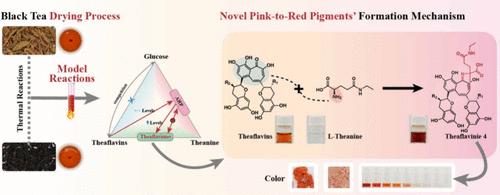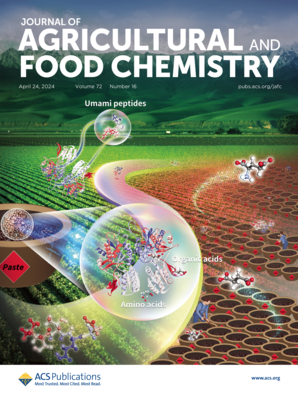Novel Pink Pigments Produced by Thermal Interaction of Theaflavins, Theanine, and Glucose: Color Formation, Isolation, and Structural Characterization
IF 5.7
1区 农林科学
Q1 AGRICULTURE, MULTIDISCIPLINARY
引用次数: 0
Abstract
A color-deepening effect of theaflavins on the theanine-glucose thermal reaction model was revealed. Generated chromogenic intermediates in the initial stage and an accelerated browning rate through the promoted degradation of theanine-glucose Amadori rearrangement product in the intermediate and final stages are responsible for the color-deepening effect. Four pink-to-red theaflavin-theanine intermediates were verified as theaflavinies referencing the nuclear magnetic resonance and liquid chromatography–mass spectrometry information on theaflavins and l-theanine, including one accurately identified as theaflavinie 4. Theaflavinie 4 showed two maximum absorption peaks at 401 and 506 nm with parallel intensities, which resulted in a significant dichromic color change from pale pink to orange and red. Theaflavinies also could undergo further thermal reactions to yield brown polymers under higher temperatures (130 and 140 °C). This research provided new insight into realizing thermally formed polymers during black tea processing, which may be formed by oxidation products and amino acids or proteins through non-enzymatic thermal reactions.

通过茶黄素、茶氨酸和葡萄糖的热相互作用产生的新型粉红色颜料:颜色形成、分离和结构表征
研究揭示了茶黄素对丙氨酸-葡萄糖热反应模型的褐变效应。在初始阶段产生的致色中间体,以及在中间和最后阶段通过促进丙氨酸-葡萄糖阿莫多利重排产物的降解而加快的褐变速度,是造成这种颜色加深效应的原因。参考有关茶黄素和 l-茶氨酸的核磁共振和液相色谱-质谱信息,验证了四种粉红色至红色的茶黄素-茶氨酸中间体为茶黄素,其中一种被准确鉴定为茶黄素 4。茶黄素 4 在 401 纳米和 506 纳米波长处显示出两个最大吸收峰,且强度平行,这导致其颜色从淡粉色显著变为橙色和红色。在较高温度(130 和 140 ℃)下,黄素还可进一步发生热反应,生成棕色聚合物。这项研究为实现红茶加工过程中的热形成聚合物提供了新的视角,这些聚合物可能是由氧化产物和氨基酸或蛋白质通过非酶热反应形成的。
本文章由计算机程序翻译,如有差异,请以英文原文为准。
求助全文
约1分钟内获得全文
求助全文
来源期刊
CiteScore
9.90
自引率
8.20%
发文量
1375
审稿时长
2.3 months
期刊介绍:
The Journal of Agricultural and Food Chemistry publishes high-quality, cutting edge original research representing complete studies and research advances dealing with the chemistry and biochemistry of agriculture and food. The Journal also encourages papers with chemistry and/or biochemistry as a major component combined with biological/sensory/nutritional/toxicological evaluation related to agriculture and/or food.

 求助内容:
求助内容: 应助结果提醒方式:
应助结果提醒方式:


